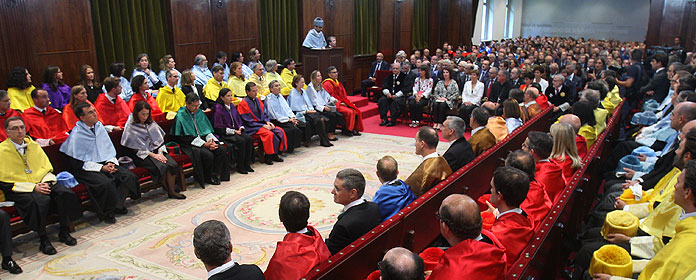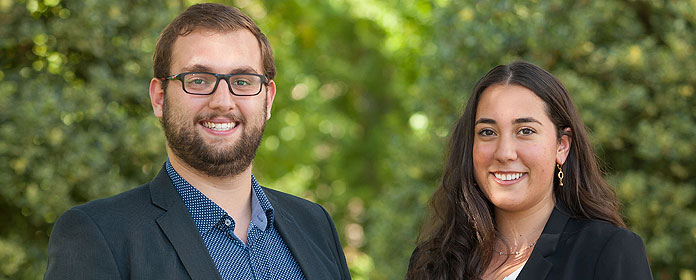The University is committed to promoting projects with a social impact: the Science Museum, IDISNA and innovation professor
The President highlights the need for empathy and partnership: "An example is IDISNA, which will produce science at the service of the health of all citizens".

"We are a University that wants to have empathy and aspires to offer projects with social benefit," said today the President of the University of Navarra, Alfonso Sánchez Tabernero, during the official opening ceremony of the 2018-2019 academic year.
"At the University of Navarra, empathy has first of all an internal dimension, which consists of the capacity for understanding between Schools, services, Departments and research. But external empathy is also crucial," noted President. A good example of this, he said, is IDISNA, the high school of research Sanitaria de Navarra. "The gestation process has result been somewhat tortuous, but after several years of work is about to be accredited an institution that integrates the Navarra Hospital Complex, the Clínica Universidad de Navarrathe CIMA Navarrabiomed and the biomedical areas of the Public University of Navarra and the University of Navarra".
The result, he added, will be a "powerful" network of teams from research with professionals from the public and private sectors, who will obtain more resources for their work at research and "who will produce science at the service of the health of all citizens".
partnership As he said in his speech, "institutions that seek to achieve a relevant social impact cannot work in isolation, without the support of many other people and entities. Certainly, we cannot get along with everyone, because some people engage in violent behavior or destructive and antisocial attitudes. But they are not the majority. We always have opportunities to connect, to reach agreements, to share tasks, to undertake collaborative projects."
In addition to a paradigm of empathy, the President referred to IDISNA as an example of the implementation of projects to serve society, one of the main objectives of the academic institution. And along with this initiative, he highlighted the innovation professor, the offer of postgraduate program and the new headquarters of the Science Museum. "Today I can assure that the pace of launching new projects will not slow down. We have a good issue of ideas in the analysis phase and others that we will start soon," he stressed.
Science Museum: one million records open to the citizens of NavarreRegarding innovation in teaching, he explained that it consists of fill in traditional classes with seminars, groups of work, sessions in laboratories and workshops, artistic and cultural initiatives, as well as various forms of integrated learning and service learning, so that "each student is the protagonist of his process of training". He also spoke about the new Degrees for this coming academic year 2018-19: the Degree in Philosophy, Politics and Economics and the double Degree in History and International Office.
Regarding the renewal of the offerings of postgraduate program, he referred to the new master's degrees in General Health Psychology, programs of study of Commissariat, Architecture and Corporate Reputation, the first two in Pamplona and the other two at the new campus in Madrid. "And we remain attentive to social demands, to ensure that every year more and more students want to fill in their training -in many cases, after an enriching work experience- at the University of Navarra."
Thirdly, he focused on the Science Museum. "With this initiative we wish to share with society - and in particular with the citizens of Navarre - the extraordinary heritage of the University's natural science collections," he said. The Museum currently has more than one million museum records, partly from private donations, and preserved thanks to more than 50 years of work of research and teaching in the field of biodiversity and the environment.
The Museum, according to President, is conceived as an interdisciplinaryproject , as a museum that educates, researches and communicates science: "It will organize educational activities that will transmit to new generations the need to take care of nature". In addition, it aims to become "an interpretation center and research of environmental problems, and a place for the dissemination and knowledge dissemination of science, with the most innovative communication resources".
Rankings: issue 8 in Europe in teaching and 48 in the world in employabilityProfessor Sánchez-Tabernero took stock of some of the most significant data of the past academic year, such as the "A" experience of the students, reflected in a study that placed the University among the top ten European universities in terms of student satisfaction; or the employability of graduates, which was positively reflected in another report where 92.5% claim to have employment or to be extending their training six months after finishing their programs of study.
He also detailed other important events of the 17-18 academic year, such as the inauguration of the Madrid campus , which includes the new Clinic building -with 570 employees and more than 25,000 consultations since its opening- and the Alumni Building, which will be officially inaugurated on October 4. "We are convinced that the new campus in Madrid will increase our notoriety and reputation and, therefore, will contribute to the strengthening of campus in Pamplona," he added.
Likewise, he highlighted the process of internationalization, which continues to increase. According to last year's data , "24% of first-year students come from outside Spain, as well as 41% of students in Master's Degree and 30% of students in doctorate. These high percentages have enriched the experience of the students, who are preparing to work in a global world".
These advances, according to President, have improved the position in some rankings, such as the Times Higher Education, where the University ranked eighth place in the ranking of the best European universities at teaching, and the QS World University Ranking, where it was ranked 48th in the world in employability.
22 million euros in grants for research, scholarships and other projectsThe President concluded by thanking all employees for their work and also the efforts of those who support the University, particularly the graduates and the association of Friends who, together with other benefactors, contributed last year "22 million euros for research, scholarships and other projects".
The opening began with a Eucharistic concelebration, presided over by the Archbishop of Pamplona and Bishop of Tudela, Francisco Pérez. Then, the academic ceremony began with the parade of the procession to the classroom Magna, in which more than 250 doctors participated, and the subsequent reading of the summary of the report of the last course, to position of the University Secretary, Gonzalo Robles.
Then, Professor Pedro Crespo, from the technical school of Engineers of San Sebastian, gave the inaugural lecture "From the Information Bit to the Quantum Bit: A History of Telecommunications". The Full Professor in Signal and Communications Theory highlighted the social influence that Telecommunications and Information technology has had in recent times. "In the last 50 years social behavior has been influenced by this scientific discipline . That is, by all those theories and systems that enable the transmission of information between people, people and machines or between machines, such as the internet of things".
Pedro Crespo, who developed the first ADSL prototypes in the 80s, gave a brief overview of the history of telecommunications and information technologies by the hand of Claude Shannon, the father of this Theory: "At a time of change in the telecommunications paradigm Shannon discovered how mathematical algorithms are vital for our information society", said the Tecnun professor, who develops his research in this field.
AuthoritiesThe musical part of the event was performed by the choir of the University of Navarra, directed by Ekhi Ocaña, position . Among the authorities who attended the event were the President of the Government of Navarra, Uxue Barkos; the President of the Parliament of Navarra, Ainhoa Aznárez; the Councilor of Education, María Solana; the Councilor of Culture of the City Council of Pamplona , Maider Beloki; the President of the Superior Court of Justice of Navarra, Joaquín Galve; and the Chief Prosecutor of the Superior Court of Justice of Navarra, José Antonio Sánchez Sánchez-Villares.
Also in attendance, among other guests, were the second vice-president of the Parliament, Alberto Catalán; the vice-president of development Económico del Gobierno de Navarra, Manuel Ayerdi; Unai Hualde, first vice-president of the Parliament of Navarra; Maiorga Ramirez, first secretary of the Parliament of Navarra; the ombudsman of Navarra, Javier Enériz; the president of the committee of Navarra, Alfredo Irujo Andueza; the president of the Chamber of Comptos, Asunción Olaechea; the president of the committee of Navarra, Alfredo Irujo; the President of the UPNA, Alfonso Carlosena; the director of the associated center of the UNED in Pamplona, Carmen Jusué; and Luis Jesús Fernández Rodríguez, director of the associated center of UNED Tudela.

